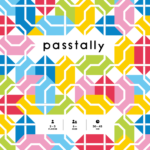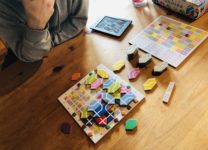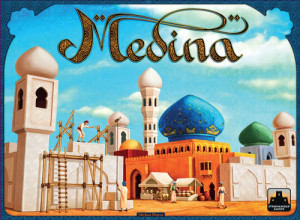- Learning time
- 10 minutes
- First play time
- 60 minutes
passtally
Designed by: Masaki Suga
Despite the gentle colours (passtally being a somewhat strained pun on the presentation and the scoring system) this is not a gentle game – it’s tough on the brain and, played right, tough on the players.
There is a board with a network of paths (horizontal and vertical) and a number of tiles made up of various colours; each colour having a specific set of paths on them that will change the destination of the paths on the board. The tiles are split into three piles that players may draw from (the top tile will be face-up). At the start of the game each player places four markers around the board – one on each side – and during play you’ll be placing tiles to try and make sure you have a marker at either end of these paths – with four markers, that’s a maximum of two paths each turn, but sometimes you may find that even creating one is a bit of a challenge…
On your turn you have two actions. You can use an action to place a tile as above, or you can move one of your markers up to two spaces around the perimeter of the board, and mix or match these choices as you like. You have two goals really: the most important one being to maximise your points. It’s relatively simple to get a path from point A to point B, but you score for every tile you pass through and tiles make stack* up: passing through a single tile counts as one pass, but passing through a stack of two is two passes, three is three passes and so on.
*A stack is where combined tiles have built up like bricks in a wall – note that it’s illegal to place one tile directly on top of another.
Once your passes are totalled up, you’ll score a number of points for them – in the early game this will only be one or two points, but as the tiles build up so do the passes – it’s possible to go well over fifty!
Your other goal is to try and disrupt your opponent’s paths at the same time, and extending your own path whilst sabotaging theirs is really the perfect turn in passtally. The game ends either when one player reaches 50 points, or one of the draw piles is emptied – in either case, this will be the final round and the player with most points is declared winner!
Joe says
Pastally is an ingenious puzzle, and as the board builds up it quickly becomes paralysing with possibilities. That's not necessarily a criticism, but you've got to be in the mood for it, and so has your opponent. It would be no fun to lose with the feeling that if only you hadn't been rushed you'd have spotted the winning move. It's nice that the box accommodates three, but I haven't tried it and don't wish too, the brain burn would be exponential. Extra marks for the very chunky cardboard bits.
The guru's verdict
-
Take That!
Take That!
You can play passtally focused entirely on your own evolution of scoring, or more destructively on your opponent. A blend of both is probably the right way to go.
-
Fidget Factor!
Fidget Factor!
High on a first play, and potentially getting higher. Players need to sit down ok with passtally's laidback approach to play.
-
Brain Burn!
Brain Burn!
High! Although to be clear, the rules are exceedingly simple. But every tile can be implemented in numerous ways, and when you have the potential for two tiles suddenly the options become numerous. That said, finding that safe-cracking combination that explodes into a firecracker of a score is so, so, satisfying....
-
Again Again!
Again Again!
It's always the same challenge, but it's never predictable thanks to the fall of the tiles and the almost infinite variety of construction.













Sam says
A thoughtful and slow-paced game suited to a leisurely Sunday afternoon over a frantic family or boozy weekend session. It is most definitely at its best with two; where opponents react to each other directly. With three players the thinking time really becomes elongated to the point where the game, for us, started to fade into the background of other activities. But for the right - and importantly, balanced - opponents, passtally provides a nice, brain-burning hit of path-laying puzzles; a head-scratcher on playing without being a headache on the rules.